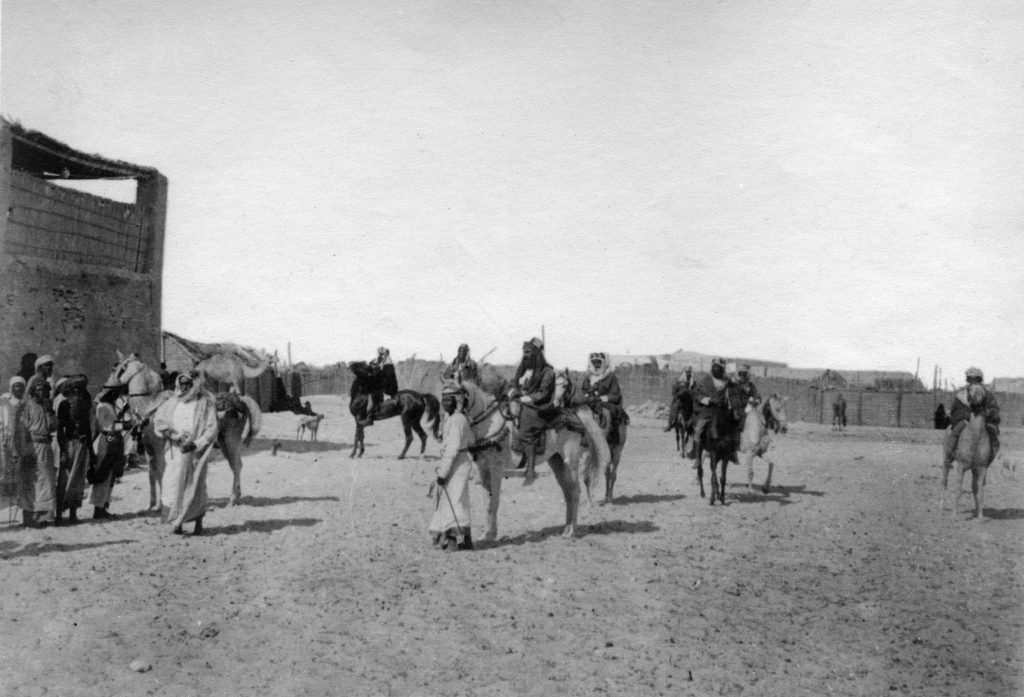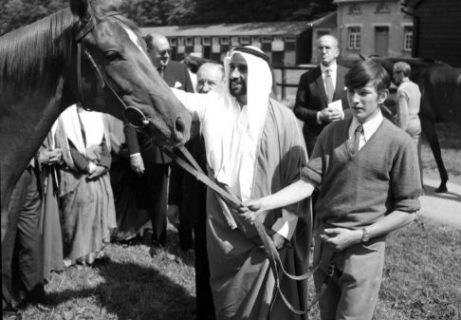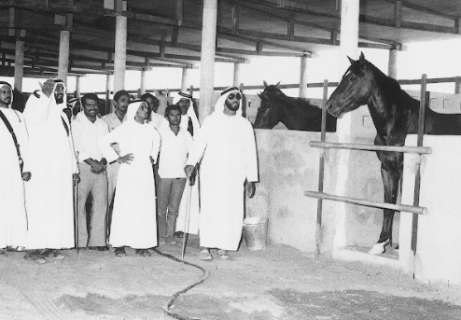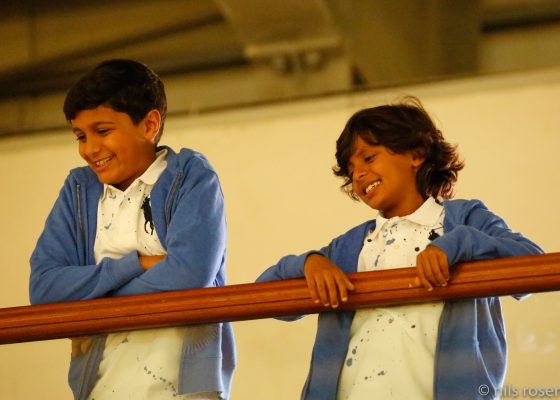
Sheikh Zayed Bin Khalifa (the First) next to his horse in Abu Dhabi in 1903. Source: UAE National Library and Archives
The Arabian horse is one of the world’s oldest and purest breeds, with a history that dates to the beginning of civilization. Genghis Khan, Napoleon, Alexander the Great, and George Washington all famously rode Arabian horses.
Originating in the harsh desert conditions of the Middle East, this compact, efficient breed with incredible stamina, intelligence, hardiness, gentle disposition, and loyalty evolved as a direct result of the hot climate, and became both a necessary tool for survival and the most valued possession of its rider.
Arabians are medium-sized (between 14.2 and 15.3 hands), short-coupled with one less rib than all other breeds of horse, and have a lean muscle mass. They are bred for efficiency and longevity. Because of their large lung capacity and efficient metabolism, they can carry heavy loads over long distances in extreme heat and with little water. When the heavy-boned, sturdy war horses of the Middle Ages were replaced by light, swift, and agile cavalry mounts with great endurance, European horses were introduced to extensive infusions of centuries-old pure Arabian blood.
Considering that the Arabian was the originator of speed and performance, and continues to be the standard bearer in endurance and reliability, the breed either directly or indirectly contributed to the emergence of nearly all contemporary horse breeds. The Arabian remains one of the most prevalent and versatile breeds today. In addition to largely monopolising the endurance and competitive trail disciplines globally, the Arabian is popular in a variety of disciplines such as English and Western pleasure, cutting, reining, jumping, dressage, and driving.
Foreword by
HH Sheikh Zayed Al Nahyan
to the book The Arabian Horse: History, Mystery and Magic by Hossein Amirsadeghi.
In The Name of God, The Merciful, The Compassionate
Among my earliest childhood memories are the beautiful Arabian horses owned by my father, Sheikh Sultan bin-Zayed Al-Nahyan, Ruler of Abu Dhabi from 1922 to 1926. In the family we had up to 180 horses in Abu Dhabi and in our summer home of Al Ain.
I have been able to ride as long as I can remember. My elder brothers used to joke that ‘Zayed could ride before he could even walk.’ In the years since, my love of the Arabian horse has continued to grow.

Riding and hunting have been my twin passions in life, ever since, at the age of eight, I went on my first hunting expedition or ganas. I had just learnt how to train falcons to pursue the houbara bustard and how to shoot a rifle.
Our ancestors have been horsemen from time immemorial. As is shown by recent discoveries of 2,000-year-old horse burials at Mileiha, each animal carefully equipped with its bridle and bejewelled trappings, the horse has long been given an honoured place in our culture.
My grandfather, Sheikh Zayed bin-Khalifa, who became known as ‘Zayed the Great’, was a fearless horseman and a great warrior who has been a source of inspiration to me throughout my life. He was tall and powerful, and a fine horseman, sometimes riding out to battle on a favourite steed. Indeed, in one such conflict in 1868, his charger was shot under him in man-to-man combat.
I have inherited his love of the horse, a love rooted deeply in the history of our people. It has become part of my belief in the essential goodness of nature and of man. Such beliefs, emanating from the religious faith in Islam, have sustained Arabs throughout history. The Arab horse, the asil breed of the desert, noble harbinger of strength, beauty, courage and fidelity, has always been a part of this history.
It was the Prophet himself, may peace be upon him, who proclaimed: ‘Bounty and happiness are on the back of the horse, they throw gold which people may hold.’ And it was he who said: ‘He who keeps a mare for the sake of God deserves his mercy and generosity.’
The horse has always meant more than just a means of transport to us. It has been a treasured possession in war and peace, a measure of wealth, and finally a source of pride and joy. The Arabian horse has, indeed, been a partner to our people, a beloved companion, a giver of strength in times of need, whether in battle, in the hunt or for the values it has personified -values shared with the true desert Bedu: those of chivalry, generosity, mercy, strength, endurance and self-reliance.
As children we learnt to love the horse, the foal becoming part of the family in the care that each member took in its rearing. And the horse in turn learnt to become a partner to man, enduring physical hardship and facing any danger for its master -a permanent presence around the tent and camp fire, often sharing the place of sleep. So close did the relationship become that the Arab horse developed an uncanny, almost human, intelligence.
The precarious and fluctuating existence of the Arabian desert has not only created the asil pure-bred Arab horse, but has moulded its owner-companion; both have had to develop hardiness and grace under the most trying of nature’s conditions.
Living in the desert defines the man as one who has shifted his own rocks in life, caught his own game, planted for himself, hunted and squeezed his own trigger. A man steadfast in his spirituality and belief in simplicity; one who turns for guidance to his faith. For God alone has power and there is no power apart from Him.
With the onset of development, I feared for the disappearance from the Middle East of the true desert Arabian. Over the past thirty years, therefore, I have taken pains to collect horses of the best bloodlines from all over the world; horses of great beauty, of speed and of endurance. These are now being bred in Abu Dhabi and in the desert to stimulate a revival of interest within the region in the asil Arabian and in its survival for future generations. I, and others, can now say with some satisfaction that there has been a renaissance in the fortunes of the asil breed throughout the Arabian Peninsula and the rest of the world.
My young horses are brought up in freedom in the desert, where they roam at will and adapt to their natural surroundings. Camel’s milk and dates are an essential part of their daily rations, as they were for the horses of my youth. Like those horses, my youngsters must grow to be brave, tough and strong. As one of our leading poets puts it:
Good horses are few, like good friends,
Though they appear many to the inexperienced eye.
We Arabs have a natural empathy with our horses. This has helped me both as a horseman and as a breeder to look for the best attributes of the asil horse: a long arched neck and a deep body culminating in powerful quarters. The head should have short ears, a broad forehead, wide between large eyes, large flexible nostrils and deep jaws. The hocks should be set well down, giving the horse power and ability to manoeuvre. These are the characteristics for which I seek in my breeding stock.
Today’s methods of horse husbandry are in stark contrast to our existence, and that of our horses, before the arrival of modern development. In those harsh circumstances, both man and horse shared meagre rations in a precarious environment.
Despite such hardships, we always took pains to ensure that our horses were fed before ourselves. Our lives, after all, might very well depend upon them. A bowl of mereesy (dried milk rubbed in water), a little water twice a day, once in the morning and then at nightfall, and fresh camel’s milk and dates when available.
Undernourished from birth, enduring intense heat during the day and severe cold at night, only those horses with the strength and will to live survived. It is perhaps for this reason that the Arabian has such special powers of stamina and endurance.
The Arabian’s evolution through selective in-breeding has been recorded through the centuries. This helps us today to trace the origins of the breed. Its history, mystery and magic are well recorded in this important book, which also celebrates its beauty through magnificent photography.
Fleet of foot, with perfect symmetry in body and motion, endowed with endurance and speed, fearless and vigorous yet docile and friendly, the Arabian is of august and ancient lineage, a player in history as the charger of men who have changed the world, as far apart as Saladin and George Washington. It is deserving of all the accolades which have been heaped upon it.
Proud, independent and generous like its desert master, as sturdy and adventurous as the spirit of the land, the Arabian horse can truly conquer the imagination. As we approach the end of this millennium, it warms my heart to see the progeny of the mythical horse of Baz spread across the globe and to witness the ever-increasing interest shown internationally in this superb animal whose beauty and spirit can once again be seen to grace its homeland.
But lest we forget, we should, too, acknowledge our appreciation of and loyalty to the companion and supporter of the Arabian horse, the camel, which has carried its food and water through the ages. Without it, the asil breed would not have survived, for the horse can drink as much as eight times the amount of water as a camel.
The Arabian horse was an important help to its owner in mobility on a daily basis, and for defence against his enemies. Man should also, however, acknowledge the role of the camel as the essential means of transport in the desert before the development of recent years.
O noble company of Arabs! ye
My pride and boast, o’er every company, …
Ye are a folk whose chronicles abound
With noble deeds, since valour was renowned,
Yea, from when Qahtan found a hero’s grave
Even to Shaiban’s Qais, and Antar brave,
To that Quraishite orphan, who was lord …
(KHALIL MITRAN)




